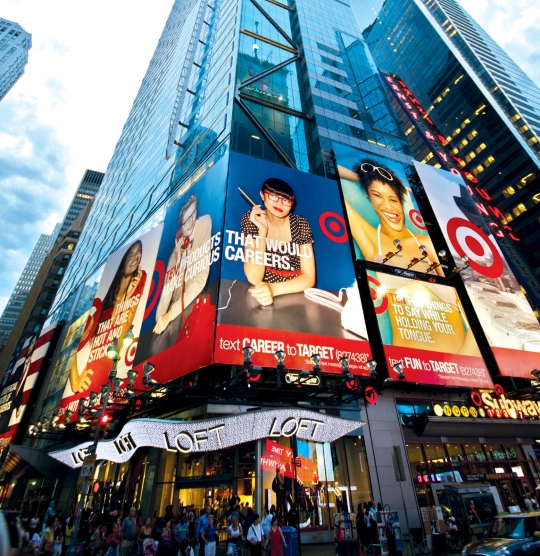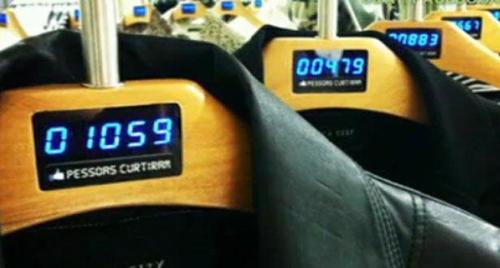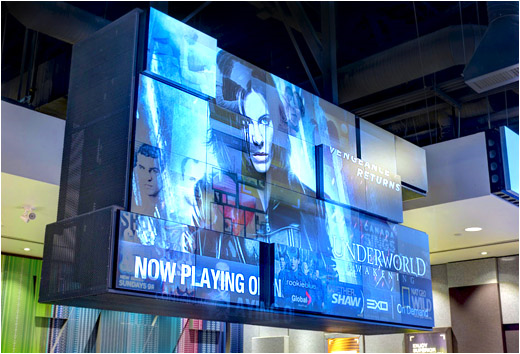After it loads, type anything on your keyboard! Pretty cool 🙂
Tips on How Retail Stores Can Beat Showrooming
Window shopping has become the thing of the past as smartphones and tablets have made it easy for people to buy things online. Showrooming or viewing items sold in retail stores and buying them online has replaced this practice. While window shopping leads to in-store sale, show-rooming does not bring business to the store itself. Armed with their smartphones and tablets while shopping, potential customers check the items they want in other online stores and compare prices. Since internet businesses have lower prices than brick and mortar stores, they usually purchase from the internet the items they saw in the store.
Do retail stores have reason to feel threatened by this phenomenon? A study on consumer behavior has shown that although shoppers would always search for the goods on the internet, this does not mean that they would buy online.
Here are some tips on how to beat the effects of showrooming.
First, build a website for your store. The internet has changed business trends and retail stores that want to remain competitive should go with the trend and aim to excel. Make a website that is appealing to customers. It must be easy to navigate to make finding products they intend to buy fast. Post product reviews, discount coupons, and other promotions in your website. Smartphone users are usually attracted to stores that offer reduced prices while product reviews help them decide what to buy.
Second, when doing a marketing campaign for your store, include relevant information such as the physical address, phone number, and other contact details. A study conducted to confirm the idea about showrooming revealed that 77% of the shoppers buy in-store even after they have viewed the items in their smartphone or tablet. Results revealed that most customers check the location of stores where the same item as that in the store is sold at a lower price. If that store is beyond five miles from where they are, their tendency is to make the purchase right there and then rather than order online. One advantage of having your own website is that shoppers in other stores who engage in showrooming could easily find you and if they prefer your store over others, you would be able to make online sales or if your physical location is accessible to them, they can do their shopping in your store.
Third, analyze how showrooming affects your business. Knowledge is power and having the right information regarding the influence of showrooming on retail stores will be a great help. Keep abreast with business trends and adopt the concepts that you deem good for your business.
Fourth, find ways to have competitive prices. Do research, especially about your competitors. If they can sell an item cheap, why can’t you? There are many ways to reduce costs that will be reflected on your store prices.
Last, take note of people’s emerging shopping behaviors. Your understanding of how shoppers’ minds work will be a great help in developing effective business strategies that would cushion you from the impact of showrooming.
Modern technology has made shopping a seamless activity. Instead of taking offensive moves such as blocking signal to prevent people shopping in your store from accessing other stores, which could drive them away, study your options and take one that will help you compete in a healthy way.
Instead of acting like hurt dogs hiding their tails between their legs in total show of defeat, brick and mortar stores should face the challenge and do something to join the flock and emerge victorious. You cannot lag behind; you should move forward and embrace change.
Image Credits:
http://fabricgraphicsmag.com/repository/5/8840/full_0910_f1_1.jpg
http://1.bp.blogspot.com/_CbdF753CjY8/TP4sHDg0ukI/AAAAAAAAAEI/z-d8ow_4Vcw/s1600/abtract-template.jpg
http://abstractartexp.weebly.com/uploads/3/1/3/1/31311361/s668589361257655194_c5_i1_w640.jpeg
http://media.tumblr.com/5d39d6f4f53253c0c4b717ac86532752/tumblr_inline_mv578wiXpG1qac9da.jpg
http://upload.wikimedia.org/wikipedia/commons/5/50/Mining_and_Scientific_Press_-_1885-07-18_-_Frue_and_Triump_ore_concentrators.jpg
http://arcadenw.org/images/uploads/content-media/30-1_Rees_Billboards.jpg
http://zurb.com/blog/system/images/1405/original/brain.png?1413917730
Wi-Fi Connection Attracts More In-house Retail Customers
It is really hard to tell how technology and connectivity can affect personal health and well-being. It can, however, affect certain economic behaviors which can dramatically influence certain actions.
Mobile gadgets, in a report published by JiWire – a mobile advertising and data provider –have been revealed to bolster retail purchase. Specifically, the report mentioned how in-store buyers are somewhat drawn towards establishments that have Wi-Fi connections.
The JiWire report assessed consumer trends and factors which may affect buying behaviors such as location, mobile usage and connection capability and readiness of establishments. This report was conducted in line with an increase on tablet and mobile gadget purchase which was up by 38 percent. The implication that online shopping is more risky for consumers was revealed to affect retailers rather than buyers. At one point of the report, it mentioned that Wi-Fi connection and accessibility actually enhance the buying experience, thus, providing the consumers with relevant information regarding choices and options for their purchases. It improves the buying experience and introduces opportunities for retailers to engage with their consumers at a more personal level, which could positively impact sales and loyalty programs.
Wi-Fi Connections and How Buyers Make Their Purchase
During the time this report was conducted, mobile trend usage in in-house retail shopping has shown that consumers can influence brand trends and even how buyers shop and make their purchase at these retail outlets.
Furthermore, those who buy at Ann Taylor are more likely (seven times) to shop at Banana Republic. People who go to Banana Republic, however, are less inclined to shop at Ann Taylor.
As shopping can be largely considered as a woman’s niche, the study stresses that women outrank men in terms of shopping for promotional deals, discounts and coupons. Women overlap men in seven mobile usage types that include searching for great buys and promos to be used for in-house retail shopping.
Wi-Fi Connections and Where Buyers Make Their Purchase
The report also mentioned how mobile device connections influence where consumers go to make in-house purchases. Moreover, mobile consumers were found out to be more likely (80 percent) to shop in retail outlets that provide Wi-Fi connections as an added value for their shopping experience. This is most likely unsurprising especially since the availability of wireless connections today is not only limited to hotels, coffee shops and airports but also shopping and retail shops.
Consumers between the age bracket of 35 to 44 years old were those that were mainly drawn and influenced by in-house mobile connectivity.
All Roads Lead to Tablet and Smartphone Proliferation
The JiWire report also mentioned how tablets and smartphones have drastically increased by more than 50 percent during the whole period of 2013. This would have been a wonderful opportunity for mobile companies since sales for mobile device has increased and grown to such , especially the third to the fourth quarter of the previous year. Seventy-two percent of current tablet owners have also revealed plans of making a second purchase, and that mobile consumers are more likely to use their tablets when given more time to use it like in hotels and airports.
Demands for more accessibility and connectivity for mobile device has grown rapidly. It is something which has not been expected by most in-house retailers. With growing trends in mobile technology, brand and buying trends have also soared alongside this. It can be easy to imagine that demands for more Wi-Fi-friendly spots in malls and shopping outlets are seen to grow over the ensuing years.
Comprising 58 percent of Wi-Fi usage, tablets and smartphones sales are projected to increase over the period. This – retailers expect – will help marketing and sales statistics dramatically. And with more sophisticated device and gadgets on its way, it does help project a better scenario for the mobile and in-house retail industry.
Image Credits:
http://core0.staticworld.net/images/article/2014/06/wifi_abstract-100315038-primary.idge.png
http://techzulu.com/wp-content/uploads/2014/01/syfkSRejuJaecgy6yn9m6ECY51Kz1bdIIJtxf0ZjpAU.jpg
http://i.guim.co.uk/static/w-620/h–/q-95/sys-images/Guardian/Pix/pictures/2013/12/26/1388080573709/53348f0c-5802-4253-8b90-41592c29a934-620×372.jpeg
http://www.google.co.in/imgres?imgurl=http%3A%2F%2Ffarm6.staticflickr.com%2F5133%2F5424988662_3fda4dedd8_z_d.jpg&imgrefurl=http%3A%2F%2Ftheurbantechnologist.com%2Ftag%2Fsocialmedia%2F&h=768&w=1024&tbnid=831CmPy3sEz8HM%3A&zoom=1&docid=emqFidlPOq4dAM&itg=1&ei=hjVzVKKnMcHgar75gPgF&tbm=isch&ved=0CFYQMygwMDA&iact=rc&uact=3&dur=507&page=3&start=40&ndsp=21
Interactive Shopping with 3 High-Tech Devices
Shoppers are in for some big changes in retail technology. And marketing ventures have encompassed and go beyond publicity and promotions, so much so that stores and other retail establishments have invested on interactive gadgetry that aims to lure in more customers by directly influencing and improving their buying experience.
In recent years, much talk has been directed towards how technology can alter buying process and the decision of buyers as well. By using technological advances in creating interactive gadgets that help shoppers in their purchase, retail establishments may be making the right move. Or are they? Although the presence of interactive machines like an electronic greeter or an interactive mirror that provides helpful advice to shoppers can be advantageous to many consumers, there are still some who may just be a little overwhelmed with these new things and, to some extent, may regard these technology as a bit off-putting if not irritating.
Patricia Aburdene, author of The Rise of Conscious Capitalism (Hampton Roads Publishing, 2010) said that the need for human touch also increases with the rise of usage in technology. She even mentioned that technology for its own sake can be considered an overkill.
“My ideal shopping experience is like a caveman hunting…” expressed Louis Rosas-Guyon, author of Nearly Free IT for Micro and Small Business (Heroic Coe Publishing, 2009) and president of a consulting firm, R-Squared Computing. The merits of shopping, according to him, rest on five criteria – speed, convenience, accessibility, soft selling and advertising-free information. He also reiterated that a technology that provides much needed assistance in efficient shopping is sure to be a winner for him.
Winner or not, here are three top picks in retail technology that will surely elicit fascination and interest among shoppers.
- Virtual Greeters. She stands just right outside the Eye See Solutions eye-care center at Wal-Mart in Plant City, Florida. A small crowd gathers around her, almost rendering them in a sort of frenzy. She addresses bystanders, coaxing them for an eye check-up without being too invasive. And wait until this virtual woman gives out QR code where curious onlookers and clients can get discounts from. Yes, she can be more than just a holographic image. Eye consultation and checkup in the Eye See Solutions in Plant City has increased by 50 percent since this device was set up. Alice Marie Bruce, the store’s manager, said that the “virtual employee” has helped the store in so many ways without actually spending a large chunk of money for it. Sales have also risen to 60 percent. She explains that most transactions were greatly influenced by the virtual greeter who mostly offers promotions and discounts through QR code displayed in the holographic image. Employing the interactive greeter is also cost effective. While a regular employee may be paid $10/hour for this job, the virtual greeter costs only a leasing fee of equivalent to $2-3/hour.
- Interactive Mirrors. As it can be quite expensive for retailers to employ their own style expert specialists, a more cost-effective measure that takes into account style and fashion queries are gaining popularity with interactive mirrors. Mirrus, the company that created this style assistant in the form of an interactive mirror have certainly provided retail stores a lot of reason to be thankful about. This device can give out style advice and tips on what goes well with what. All shoppers need to do after donning an outfit is to step in front of a full-length or countertop mirrors from which the interactive device can provide accessories to match the item. Video promotions can also be played on this multi-purpose gadget and, thus, help increase sales transactions.
- Touchscreens. A number of retail shops carry this interactive device, and has grown tremendously sophisticated over the last few months. This is usually effective for making comparisons on certain products that buyers may not be familiar with or cannot make just yet a buying decision.
Image Credits:
http://digitalsignageuniverse.typepad.com/.a/6a00e55025f7728833017c347a5ebf970b-800wi
http://fc01.deviantart.net/fs70/i/2014/142/8/c/lost_in_the_greyness_by_scheinbar-d7jaytx.jpg
http://beta.images.theglobeandmail.com/archive/01376/webretailimage__1376289cl-8.jpg
http://www.thisiscolossal.com/wp-content/uploads/2014/02/weave-1.jpg
http://pic2.sc.chinaz.com/files/pic/pic9/201209/xpic7577.jpg
The New Face of Customers
The digital age has paved the way for many new changes in the way we live. From simple daily tasks to highly specific needs, the new digital boom has made its mark. One of the aspects greatly affected by this ongoing phenomenon is the way consumers and businesses interact with each other. The flourishing of social media and the power of the internet has given the consumers a kind of power they never had before. And with new power comes fundamental changes in the consumers’ habits, practices, and behaviors. Thus, for a business to adapt and thrive in this new on-line age, they must learn to understand how customers think and behave, and what options the customers have, in order for them to know how to cater to their customers’ needs.
One of the biggest changes technology has brought is the accessibility to anything and everything. With the touch of a finger, a customer can find all the choices and alternatives available. That means they can also find the business’s competition. Unlike the old days when a customer is inside a store and they either make do with what they’re getting or go through the hassle of leaving and looking again, these days customers have a more complex buying process. It is no longer black and white. They are no longer exclusive and they have the option to be as fickle as they want to be. As such, customer loyalty becomes a hard-earned prize.
Since customers have all the power, their decision to go with one company over another then comes down to their experience. Customer experience can be a huge factor when it comes to customer retention and loyalty. Winning them over may result to a lifelong relationship, and this is what businesses must understand.
Customer experience is based on what the customer goes through the moment he enters the doors to the moment he leaves with his purchase or service. It is determined by the opinions he forms, the interactions he has with the staff, and the user experience with the product. It even involves things as simple as the mood and the feelings being in the store gives him. A consistent positive experience, plus that something extra, could assure a customer’s loyalty for life. Make no mistake, though; there is no template for a positive customer experience. Every individual has their specific wants and needs, and addressing this for each customer can go a long way. The more valued they feel, the more they would give value to the company.
With a customer’s loyalty also comes some perks. For one, loyal and satisfied customers tend to be more flexible and open when it comes to price. They can pay more because they see and acknowledge the value of their money and a company’s product or service. Their good word can also be good publicity, inviting more people to become loyal customers as well.
On the other hand, disappointment comes at a steep price. When a company fails to meet customer expectations, it almost always results in losing that customer. The ease in which customers can shift brands is so easy, that customers need not wait for corrections. Social media is also such a huge factor that bad publicity is just bad publicity. When a disappointed customer takes to social media all that is left to be done is damage control for the company. Reacting quickly makes a world of difference in preventing more harm to a company’s product or service. Again, it comes down to appeasing the customer’s needs and providing them with an experience they will not find anywhere else.
Once a business takes these things to heart and understands that in this digital age the customers have all the power, then they are on the road to meeting success and garnering their customers’ lifelong loyalty.
Image Credits:
http://1hdwalls.net/abstract-girl-face-fantasy-digital-artwork-hd-wallpaper/abstract-girl-face-fantasy-digital-artwork-2/
https://intoviews.files.wordpress.com/2013/06/square.jpg
https://guriguriblog.files.wordpress.com/2010/02/bss_genius_party_-_limit_cycle_79563821-mkv_snapshot_11-10_2010-02-20_02-08-42.jpg
http://3.bp.blogspot.com/-KasInuIB7nA/UlPdXKranxI/AAAAAAAAAaI/61SR__ShSVk/s1600/water_abstract_fire_hearts_photomanipulations_2560x1600_wallpaper_Wallpaper_1280x960_www.wall321.com.jpg
http://us.123rf.com/450wm/radiantskies/radiantskies1211/radiantskies121102085/16502437-abstract-word-cloud-for-goods-and-services-with-related-tags-and-terms.jpg
http://upload.wikimedia.org/wikipedia/commons/4/4f/Business_Feedback_Loop_PNG_version.png
The Age of Touch
For the first time in 25 years, technology has undergone a revolution like it has never gone through before. With the advent of the touch interface, human-computer interaction or HCI is being taken to new heights. Gadgets which make use of the touch interface are now taking over the market. Long gone are the days of punch cards, with keyboards and mice now only taking second place to touch interface. This is a phenomenon that is taking over the world, and it is changing the face of technology as we know it.
These days, users turn most often to their touch capable gadgets when in need to learn or find out something. When it comes to getting information, touch is the first step to the solution. People almost automatically take out their smartphones to answer queries and gather data. Touch smartphones, tablets, and other devices have become people’s “top of mind”. Only when this option fails do people then turn to their computers and, with the use of keyboard and mouse, acquire what they need.
Thanks not only to their size and capabilities, smart phones and tablets which make use of the touch interface are fast becoming people’s number 1 work machines as well. Nowadays, instead of laptops, people bring smartphones or tablets with them at work, at school, or even out in the field. Smartphones and tablets are currently a more common sight in classrooms, boardrooms, laboratories, hospitals, even at cafes and restaurants, all the way to the streets. They have become a staple in people’s lives and are now seemingly an intrinsic part of everyone’s lifestyle.
In a very short span of time, these touch gadgets have become ubiquitous. Never in the history of any mode of HCI have humans adapted as quickly as they have with the touch interface. Much of this can be attributed to the fact that there is very little effort needed for people to reach their end goal. There is barely anything sitting between the touch-enabled machine and humans. As such, there is less delay when getting information or accomplishing a task through a gadget with touch. Unfortunately, not the same can be said of keyboards or a mouse, let alone archaic and antiquated punch cards. Touch is much more intuitive, much more natural to human habits and practices, much more responsive. Thus, they make the lives of anyone who use them better and so much simpler.
With every incarnation of an HCI mode, the technology becomes more intuitive. Every transformation finds methods and technology that is more innate, more effortless for people to manipulate. And the more effortless it is to handle, the faster and easier it becomes second nature for the users. For example, using a keyboard efficiently can become second nature, but it may take a while to train the fingers to master tactile memory; where the user no longer finds himself consciously thinking of what to press next. This may take weeks, months of mastery. Another example is the mouse. Clicking and dragging is very easy, but getting used to the mouse’s movements takes practice in coordination as well. This could take hours, or even days for an unwieldy mouse. However, when it comes to touch, mastery is pretty much instantaneous. Every command or action achieved by touch, by using the tips of the fingers, is already something humans know how to do. It is an inborn skill. Thus, using the touch interface requires no practice, no training, no nothing. People can try it for the first time, and find themselves masters immediately.
What this means is the touch interface has no learning curve. Pointing, tapping, dragging, swiping with one’s fingers is so natural and automatic that users need not even acquire that skill. This ease of use has changed the way people interact with their gadgets, and have changed the way gadgets are used. What’s more, touch is also expanding the number of users. Because it requires no skill, literally anyone can use it. The moment babies learn how to point, they can use it. The elderly need not learn such high-tech and complex methods to use it too. Touch has revolutionized technology, and it has revolutionized how people use technology, and it can only open more doors in the future.
Image Credits:
http://40.media.tumblr.com/18db80e93303ec2cafde57b3616bbad4/tumblr_ndnvhmwTAo1r30t7yo1_500.jpg
http://pixeswall.com/wp-content/uploads/2014/06/creative-graphics-galaxy-touch-dark-light-of-purple-abstract-graphics-hd-wallpapers-galaxy-touch-key-light-galaxy-touchpad-galaxy-touch-screen-driver-galaxy-touch-screen-galaxy-touch-rugby-galaxy-touc-520×325.jpg
http://imgs.abduzeedo.com/files/perfect_office/19/lighttouch.jpg
http://www.tribuneindia.com/2012/20120728/trend1.jpg
http://cdn2.wonderfulengineering.com/wp-content/uploads/2013/10/Ring-Clock-3.jpg




























